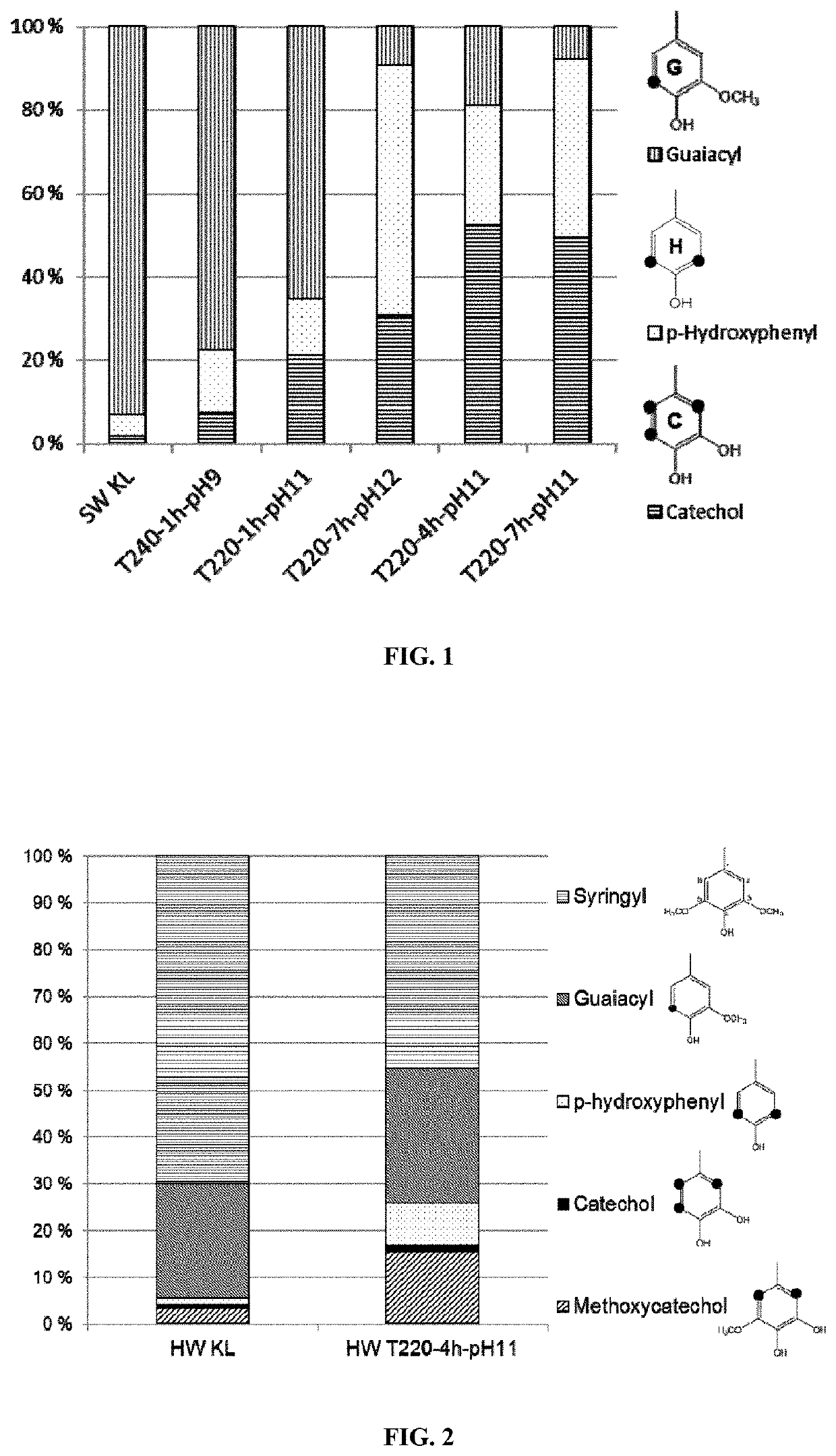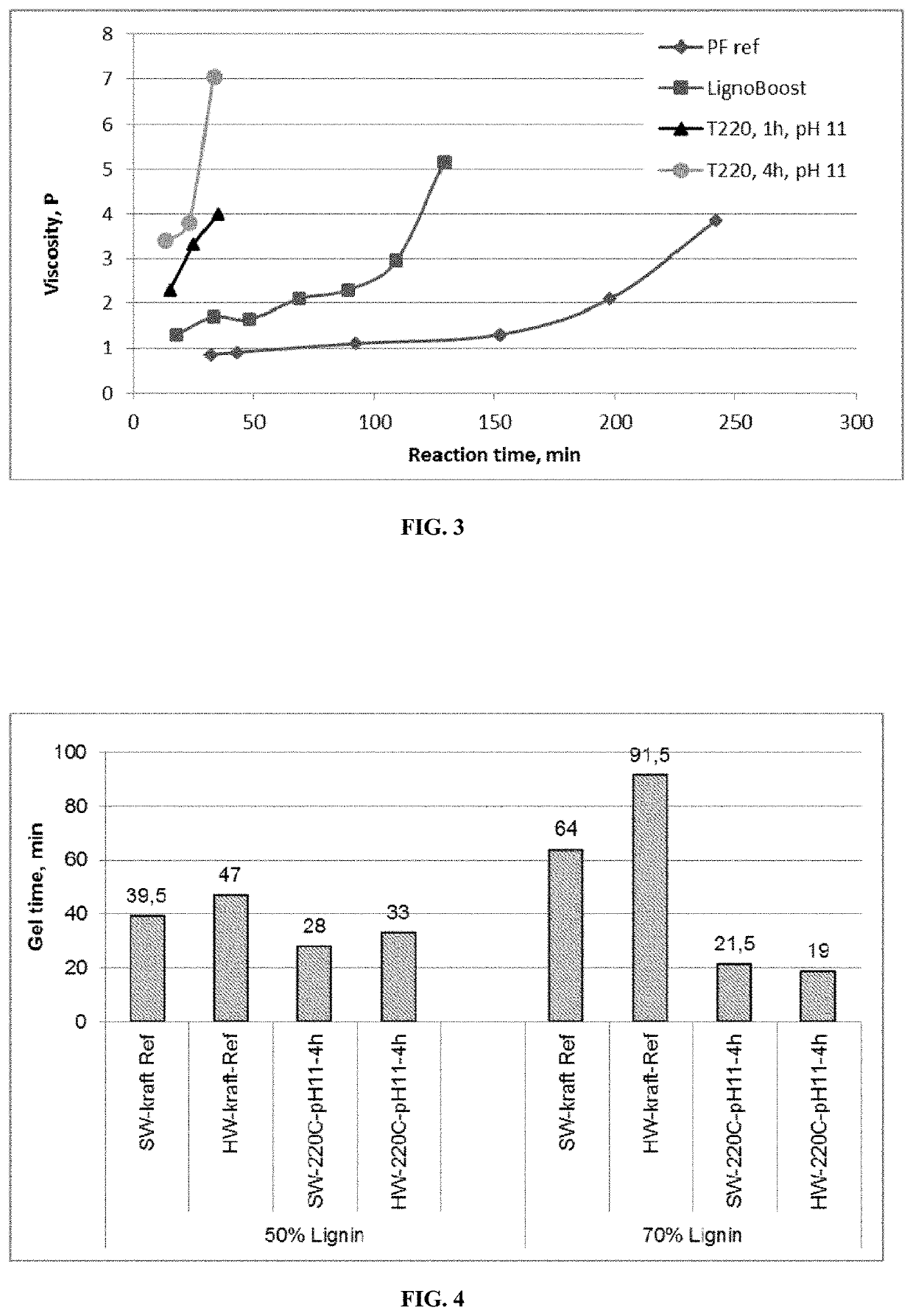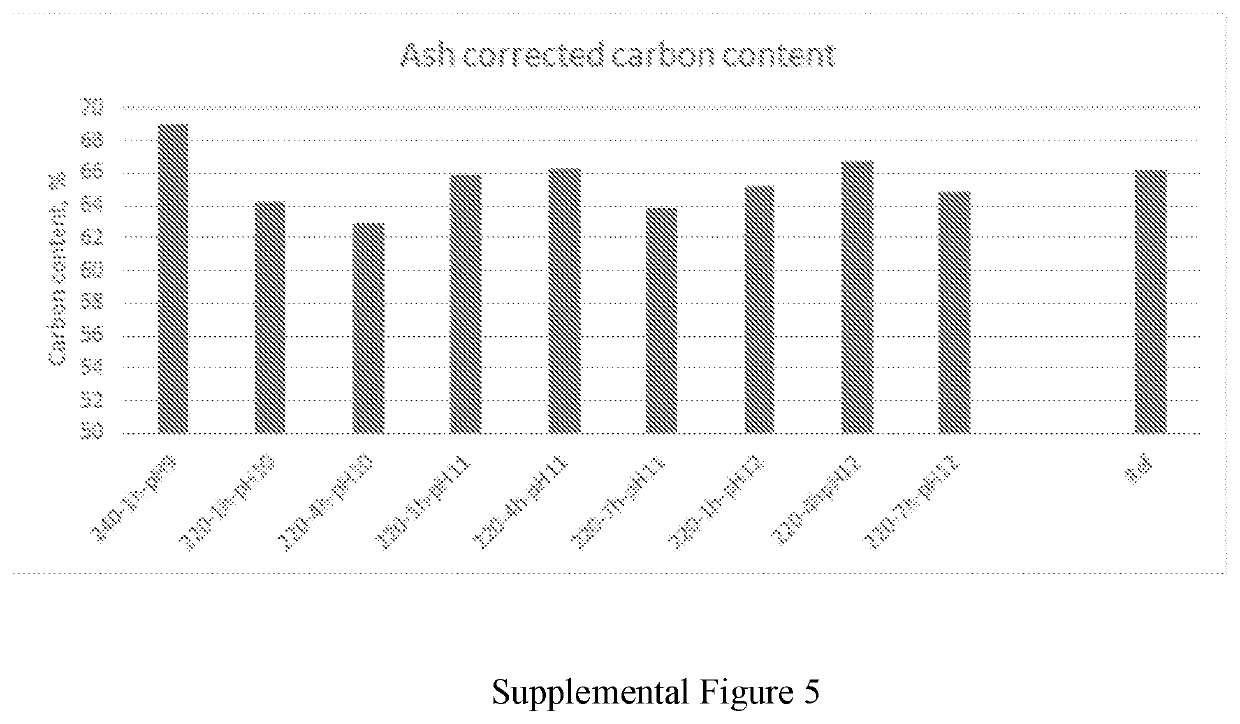Method for activating and precipitating lignin
a lignin and precipitation technology, applied in the field of lignin products, can solve the problems of limited lignin reactivity, limited application of hardwood lignin in pf resins, and insufficient cost-competitive or otherwise efficient, so as to improve the antioxidative properties of produced lignin and improve metal chelation efficiency
- Summary
- Abstract
- Description
- Claims
- Application Information
AI Technical Summary
Benefits of technology
Problems solved by technology
Method used
Image
Examples
example 1
ethod
[0059]Black liquor from softwood and hardwood kraft pulping process[0060]Dry content of the raw material: 10-50 wt-%, Trials done at 20 wt-% and 30 wt-%
Method[0061]Temperature of 200 to 250° C.[0062]Residence time 30 min-10 h[0063]Self-generated pressure 15-40 bar[0064]pH alkaline 9-13[0065]Product purification after the activation and precipitation: the lignin material is purified by acidic washing
[0066]In this example, black liquor from softwood kraft pulping process having dry content of 20-30 wt-% was placed into a reactor and pH was adjusted between 9-12 using CO2 as a pH lowering agent. Then the black liquor was thermally treated in the temperatures between 220 and 240° C. under pressures between 15-40 bars for 1 to 7 hours. Then the activated and precipitated lignin was separated from the remaining liquid in a centrifuge. The separated lignin was purified using acidic washing and dried. Hardwood black liquor was treated similarly at 220° C. and pH 11 for 4 h....
example 2
Analysis
[0071]The elemental composition of the lignin products was analyzed and compared with the industrial lignins. Feedstock was in most cases softwood kraft lignin. It can be seen from Table 3 that the elemental composition is rather similar to typical industrial softwood kraft lignins.
[0072]
TABLE 3% dryC %H %N %O %S %Ash %Na %Softwood:T220-1h-pH 1263.95.2n.d.n.d.2.12.0n.d.T220-1h-pH 1063.35.0n.d.n.d.2.31.4n.d.T220-4h-pH 1265.14.9n.d.n.d.2.22.5n.d.T220-4h-pH 1061.34.4n.d.n.d.2.52.5n.d.T240-1h-pH 966.64.60.223.31.83.50.8T220-1h pH 1163.54.90.126.02.53.61.1T220-4h-pH 1164.14.50.124.22.73.20.9T220-7h-pH 1162.14.20.123.62.42.80.6T220-7h-pH 1262.94.40.123.42.53.00.7Referencelignins:LignoBoost ™a)63.6-66.25.7-6.20.1-0.225.9-27.51.8-3.20.2-1.4 0.17Indulin ATb)64.55.41.024.71.92.40.8HW KLb64.56.20.330.22.62.1n.d.Hardwood:T220-4h-pH 1166.95.00.2n.d.2.11.7n.d.a)Tomani, P (2010) The LignoBoost process. Chellulose Chem. Technol., 44 (1-3), 53-58b)Beis S H (2010) Fast pyrolysis of lignin. Bi...
example 3
Development in Phenol Formaldehyde Resin Synthesis
[0073]PF resin synthesis were performed using 100% phenol (PF Ref), and substituting 50% phenol with softwood LignoBoost lignin or thermally separated and activated lignins (220° C., 1 h, pH 11 and 220° C., 4 h, pH 11). Formaldehyde / phenol ratio of 2 and NaOH / phenol ratio of 0.55 was used. All the other chemicals besides formaldehyde were first mixed and reaction temperature was increased to 55-60° C. Formaldehyde was then added during 10 min, resulting in temperature increase to 70-85° C. The actual condensation phase was carried out at 85° C. and the reaction was followed according to the viscosity.
[0074]As shown in FIG. 3 all lignins had faster viscosity increase and shorter reaction time due to already cross-linked polymeric nature compared to phenol. The reactions of thermally separated and activated lignin were faster compared to LignoBoost, supporting faster crosslinking due to the higher amount of reactive sites. As shown in ...
PUM
| Property | Measurement | Unit |
|---|---|---|
| temperature | aaaaa | aaaaa |
| temperature | aaaaa | aaaaa |
| pressure | aaaaa | aaaaa |
Abstract
Description
Claims
Application Information
 Login to View More
Login to View More - R&D
- Intellectual Property
- Life Sciences
- Materials
- Tech Scout
- Unparalleled Data Quality
- Higher Quality Content
- 60% Fewer Hallucinations
Browse by: Latest US Patents, China's latest patents, Technical Efficacy Thesaurus, Application Domain, Technology Topic, Popular Technical Reports.
© 2025 PatSnap. All rights reserved.Legal|Privacy policy|Modern Slavery Act Transparency Statement|Sitemap|About US| Contact US: help@patsnap.com



